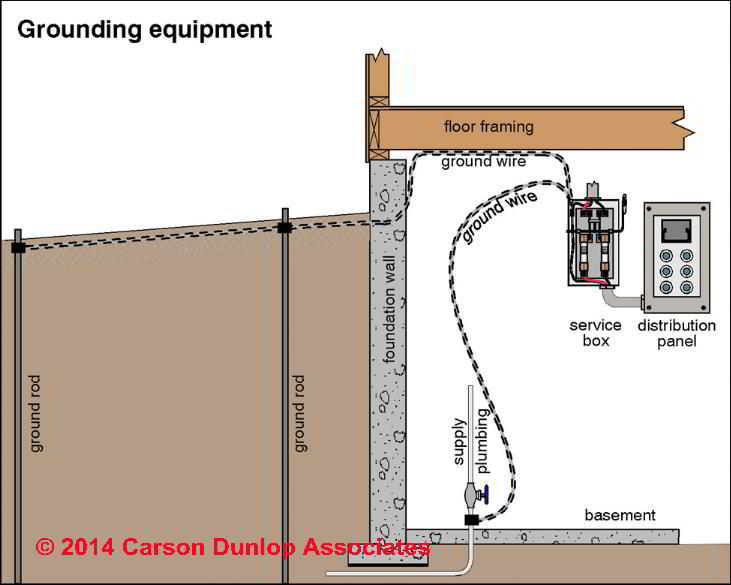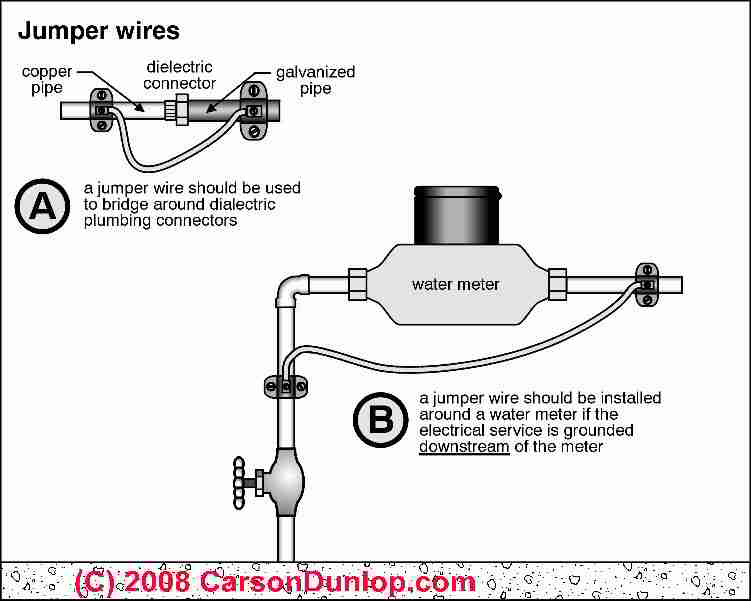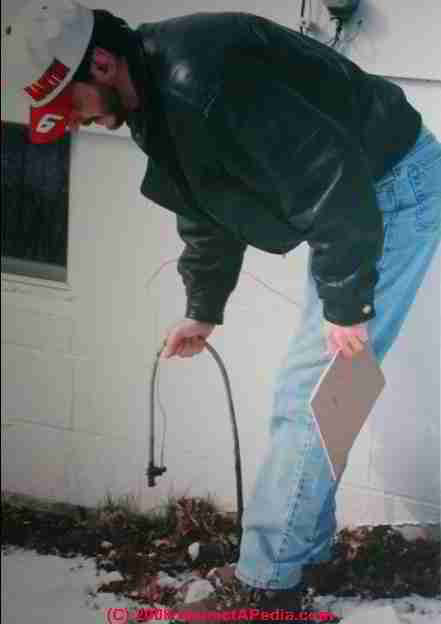 Electrical Ground System Definitions
Electrical Ground System Definitions
Definitions of electrical ground, grounding, grounding electrode,bonding, ufer &c
- POST a QUESTION or COMMENT about definitions of terms used for the electrical ground system at buildings & lightning protection systems
Definitions of electrical ground, grounding, grounding system components & terms:
This article defines the terms used to describe the building electrical grounding system & its components, including grounding & grounded conductors, grounding electrode, bonding, ufer and related terms.
Page top sketch and sketch just below are provided courtesy of Carson Dunlop Associates, a Toronto Home Inspection & Training company,
InspectAPedia tolerates no conflicts of interest. We have no relationship with advertisers, products, or services discussed at this website.
- Daniel Friedman, Publisher/Editor/Author - See WHO ARE WE?
Building Electrical Grounding System Terms & Definitions
Here are some elementary electrical ground, grounding, and ground wire definitions to help us get our terms straight when discussing electrical grounds, grounding, and ground bonds.
[Click to enlarge any image]
Page top sketch and other electrical ground system sketches used in this article are used with permission and were provided courtesy of Carson Dunlop Associates, a Toronto home inspection education firm and inspection firm.
Ground: means the physical earth, the soil or ground. In some countries the term earth is used and is synonymous with ground. In the electrical code, ground means an electrically conducting connection, intentional or accidental, between an electrical circuit and the earth.
Grounded means that something has been electrically connected to the earth. Watch out: even among inspectors and electricians, people may use the term "ground" more loosely to refer to the equipment grounding conductor or other components. Also see Grounded Conductor (below).
What is a Grounding Electrode?
Grounding electrode or ground electrode: a metal conductor, usually a solid copper-alloy rod of specified length, driven into the ground in order to provide a point for electrical connection between the building grounding system and ground or earth.
Photo above: during an inspection conducted by the author (Friedman) we found and our client demonstrated a "fake" grounding electrode, a scrap of steel driven just a few inches into the soil.
In the electrical code, the grounding electrode conductor is the conductor (a wire) used to connect the grounding rod(s) to the equipment grounding conductor (the ground bus and ground wires in the electrical panel) OR to the grounded conductor (the neutral bus and neutral wires) OR to connect both of these to the grounding electrode (which is usually the case in residential electrical systems).
What's the difference between "Grounded electrical conductor" and "Grounding Conductor"?
Grounded Conductor (the neutral wire): by convention the grounded conductor or neutral wire is white or gray. In an electrical circuit the grounded conductor (white or neutral wire) normally carries electrical current between the un-grounded (hot) electrical wire and (back through the main electrical panel and grounding system) earth.
In the electrical code, a grounded conductor is one which has been intentionally grounded - connected to the earth.
The amount of current carried by the neutral wire is called the un-balanced load and depends on the characteristics of the electrical device being operated by the circuit. The neutral conductor is grounded in the main electrical panel. Be careful, inspectors and electricians, speaking loosely, may simply call this the "neutral wire".
Equipment Grounding Conductor (the ground wire): By convention the equipment grounding conductor (ground wire) is bare copper or carries green insulation. the individual wire in a (grounded) electrical circuit that is connected through the ground bus in the electrical panels and ultimately in the main electrical panel is connected to ground or earth.
In the U.S. National Electrical Code and most other model electrical codes, a grounding conductor is a conductor (metal wire, metal bar, etc) which is used to connect electrical equipment (like an electrical panel enclosure) or the grounded circuit (the neutral wires) of a wiring system to a grounding electrode (and thus to earth).
The ground wire in an electrical circuit does not normally carry any electrical current, but it remains available as an emergency path to allow current to flow to earth should an electrical fault such as a short circuit occur (a connection between a hot wire and some metal (conductive) material that could cause an electrical shock to someone), thus assuring that a fuse or circuit breaker in the main panel can sense the current flow and switch off the circuit.
Watch out: In an older two-wire armored cable (BX) electrical circuit, the metallic cable of the circuit may be serving as the only grounding conductor. This is not a safe installation: should the metallic cable sheath carry live current (say due to a fault or faulty electrial wiring) someone touching the BX cable can be shocked - an event witnessed by the author.
It helps to keep these terms straight if we remember that we use the ing form of the word grounding to mean that this conductor causes an electrical connection between earth and whatever the grounding conductor is connected to.
In the electrical code, a grounded conductor is one which has been intentionally grounded - connected to the earth. As reader WT Smith points out below, the grounded conductor is not necessarily synonymous with the neutral conductor.
Really? In a comment posted originally
at DEFINITIONS of ELECTRICAL TERMS, Reader W. Thomas Smith noted by comment (28 Oct 2015) the following:
Please note that referring to "Grounded Conductor" and "Neutral conductor" as synonymous is deprecated by the NEC. There are many installations where the grounded conductor is NOT a neutral conductor, including the very common 3-phase 240/120 "high leg" delta installation, where the grounded conductor is definitely not a neutral. It is required that the "Grounded Conductor" be white or gray; the neutral conductor is not required to be this color unless it is grounded.
I suggest changing the definition of "Grounded Conductor" to omit the present reference to the neutral conductor, and add a sentence or parenthetical comment (usually the neutral conductor on single-phase).
Electrical Bonding Definitions (consistent with NEC article 100)
Bonding or Bonded: means that metallic parts are permanently joined so as to assure that they form a reliably continuous electrical path and that the parts are capable of conducting any electrical current that may be imposed on them.
A bonding jumper is a reliable electrical conductor used to connect metal parts together and a main bonding jumper is the connection between the grounded circuit conductor and the equipment grounding conductor at the electrical service (panel).
Ground bond: refers to a physical electrical connection between any metal component (like metal water pipes, metal gas piping, a metal electrical panel enclosure, or a neutral or ground bus in the main electrical panel) and the building electrical ground system.
In the main electrical panel the neutral wires are physically bonded to the ground wires (by a larger diameter wire or by a metal bar inside the panel) and the ground wire bus (a metal bar) is further connected to a grounding conductor that connects those components to the building ground system: one or more grounding electrodes and possibly a connection to an incoming metal water pipe that is buried outside. An electrician would say that the building's ground and neutral wires are bonded to earth
Bonding electrical components together makes certain that all of the joined items are at the same electrical potential (that is, that current will not flow from one to the other). Examples of electrical bonds in buildings include:
- In electrical panels or sub panels the neutral wires are all bonded together on a neutral bus or bar.
- In individual electrical panels or sub-panels the ground wires are all bonded together on a ground bus or bar.
- In the main electrical panel at a building, the neutral bus and ground bus and electrical panel itself are all bonded together and are connected to the building grounding system. In a sub panel the neutral bus and ground bus are not bonded together and must be kept separate.
Definition of Ufer ground: electrical grounding using concrete & electrodes
What is a Ufer ground?
A UFER is an electrical ground connection to earth provided by a concrete encased grounding electrode. This approach to electrical grounding improves the ground connection to earth in areas where soils are so dry that otherwise grounding may be ineffective. UFER grounding has been included in the U.S. National Electrical Code (NEC) since 1968.
UFER electrical grounding was developed in 1942 by Herbert G. Ufer who worked as a consultant to the U.S. Army to improve electrical grounding for bomb storage vaults in Arizona where dry soils limited the efficacy of electrical grounding using a driven copper electrode hammered into the soil.
Below we include additional research citations on the efficacy of Ufer grounding for electrical systems & buildings where you'll see H.G. Ufer's seminal paper on Ufer ground in in bold font. Wikipedia's entry for Ufer ground points out that Ufer observed that concrete was more conductive than most types of soil, permitting grounding by concrete-encased electrodes.
In modern construction a UFER connection may refer to a continuously bonded steel re-bar (or other grounding electrode) used in construction of a concrete footing or slab that is in turn bonded to the electrical ground system for the building.
We presume that the increased area and conductivity of the larger area of concrete in contact with the soil combined with conductivity of the concrete itself is what gives an improved local electrical ground-to-earth connection for the building. - "Ufer ground", Wikipedia, retrieved 4/27/14, original source: http://en.wikipedia.org/wiki/Ufer_ground
Useful References & Citations on Ufer Grounding
- Collatz, L., G. Meinardus, and H. Unger. "Zur Berechnung des zeitabhangigen Neutronenausflusses mit der Monte-CarlodMethode."
- Durham, Marcus O., and Robert A. Durham. "Grounding system design for isolated locations and plant systems." In Petroleum and Chemical Industry Conference, 1995. Record of Conference Papers., Industry Applications Society 42nd Annual, pp. 145-153. IEEE, 1995.
- Fagan, Eugene J., and Ralph H. Lee. "The use of concrete-enclosed reinforcing rods as grounding electrodes." Industry and General Applications, IEEE Transactions on 4 (1970): 337-348.
- Hope, Roger, Dave Harrold, and David Brown. Control System Power and Grounding Better Practice. Elsevier, 2004.
- McIntosh, Donald H. "Grounding where corrosion protection is required." Industry Applications, IEEE Transactions on 6 (1982): 600-607.
- MORA, PABLO JOSÉ JIMÉNEZ. "UTILIZACION DE PILOTES DE CONCRETO REFORZADO COMO ELECTRODOS DE PUESTA A TIERRA EN LINEAS DE TRANSMISION."
- Preminger, Julius. "Evaluation of concrete-encased electrodes." Industry Applications, IEEE Transactions on 6 (1975): 664-668.
- Rowland, Phillip W. "Industrial system grounding for power, static, lightning and instrumentation, practical applications." In Textile, Fiber and Film Industry Technical Conference, 1995., IEEE 1995 Annual, pp. 1-6. IEEE, 1995.
- Stockin, David R. "Design and testing of facilities ground." In Electrical Overstress/Electrostatic Discharge Symposium Proceedings 2000, pp. 368-374. IEEE, 2000.
- Ufer, H. G. "Investigation and testing of footing-type grounding electrodes for electrical installations." Power Apparatus and Systems, IEEE Transactions on 83, no. 10 (1964): 1042-1048.
- "Ufer ground", Wikipedia, retrievd 4/27/14, original source: http://en.wikipedia.org/wiki/Ufer_ground
- Ufer grounds are cited also at DEFECTS LIST - ELECTRICAL SYSTEM and
at ELECTRICAL GROUND REQUIREMENTS we include a discussion of the remedy for the omission of UFER grounding when it may be necessary at a building. - Vaselich, R., and J. Dixon. Lightning Protection Documentation. No. NWL-AR-124. NAVAL WEAPONS LAB DAHLGREN VA, 1973.
- Wiener, Paul. "A comparison of concrete encased grounding electrodes to driven ground rods." Industry and General Applications, IEEE Transactions on 3 (1970): 282-287.
- Zipse, D. W. "Grounding: The good, the bad and the stupid." In Petroleum and Chemical Industry Technical Conference (PCIC), 2013 Record of Conference Papers Industry Applications Society 60th Annual IEEE, pp. 1-9. IEEE, 2013.
- Zipse, Donald W. "Earthing-Grounding methods: a primer." In Petroleum and Chemical Industry Conference, 2001. IEEE Industry Applications Society 48th Annual, pp. 11-30. IEEE, 2001.
- Zipse, Donald W. "Grounding." Wiley Encyclopedia of Electrical and Electronics Engineering (1999).
- Other electrical ground system citations are atReferences or Citations
...
Continue reading at ELECTRICAL GROUND INSPECTION SAFETY or select a topic from the closely-related articles below, or see the complete ARTICLE INDEX.
Or see these
Recommended Articles
- ELECTRICAL GROUND ERROR-CAUSED LEAKS
- FALSE GROUND at RECEPTACLES
- FALSE GROUND, BOOTLEG & FLICKERING LIGHTS
- FALSE NEUTRAL CONNECTIONS
- GAS PIPING GROUND BOND
- KNOB & TUBE WIRING - no ground conductor
- GROUND SYSTEM INSPECTION - home
- GROUND SYSTEM REQUIREMENTS
- LIGHTNING PROTECTION SYSTEMS - require careful grounding
- LOST ELECTRICAL GROUND
- LOST NEUTRAL SHOCKS HOMEOWNER
- SERVICE GROUNDING DEFECTS
Suggested citation for this web page
ELECTRICAL GROUND DEFINITIONS at InspectApedia.com - online encyclopedia of building & environmental inspection, testing, diagnosis, repair, & problem prevention advice.
Or see this
INDEX to RELATED ARTICLES: ARTICLE INDEX to ELECTRICAL INSPECTION & TESTING
Or use the SEARCH BOX found below to Ask a Question or Search InspectApedia
Ask a Question or Search InspectApedia
Try the search box just below, or if you prefer, post a question or comment in the Comments box below and we will respond promptly.
Search the InspectApedia website
Note: appearance of your Comment below may be delayed: if your comment contains an image, photograph, web link, or text that looks to the software as if it might be a web link, your posting will appear after it has been approved by a moderator. Apologies for the delay.
Only one image can be added per comment but you can post as many comments, and therefore images, as you like.
You will not receive a notification when a response to your question has been posted.
Please bookmark this page to make it easy for you to check back for our response.
IF above you see "Comment Form is loading comments..." then COMMENT BOX - countable.ca / bawkbox.com IS NOT WORKING.
In any case you are welcome to send an email directly to us at InspectApedia.com at editor@inspectApedia.com
We'll reply to you directly. Please help us help you by noting, in your email, the URL of the InspectApedia page where you wanted to comment.
Citations & References
In addition to any citations in the article above, a full list is available on request.
- Also See Definitions of Electrical Ground, Grounding Electrode, Grounding Conductor, Grounded Conductor, Ground Wire, Neutral Wire, Ground Rod, for definitions of these confusing electrical terms.
- More details about electrical grounding can be read at ELECTRIC SERVICE GROUNDING SYSTEM INSPECTION and ELECTRICAL CIRCUITS, SHORTS, and at OLD HOUSE ELECTRICAL SYSTEMS.
- At ALUMINUM GROUND WIRES we discuss proper repair of aluminum ground wires found in solid conductor branch circuit wiring.
- Mark Cramer Inspection Services Mark Cramer, Tampa Florida, Mr. Cramer is a past president of ASHI, the American Society of Home Inspectors and is a Florida home inspector and home inspection educator. Mr. Cramer serves on the ASHI Home Inspection Standards. Contact Mark Cramer at: 727-595-4211 mark@BestTampaInspector.com
- John Cranor [Website: /www.house-whisperer.com ] is an ASHI member and a home inspector (The House Whisperer) is located in Glen Allen, VA 23060. He is also a contributor to InspectApedia.com in several technical areas such as plumbing and appliances (dryer vents). Contact Mr. Cranor at 804-873-8534 or by Email: johncranor@verizon.net
- Our recommended books about building & mechanical systems design, inspection, problem diagnosis, and repair, and about indoor environment and IAQ testing, diagnosis, and cleanup are at the InspectAPedia Bookstore. Also see our Book Reviews - InspectAPedia.
- In addition to citations & references found in this article, see the research citations given at the end of the related articles found at our suggested
CONTINUE READING or RECOMMENDED ARTICLES.
- Carson, Dunlop & Associates Ltd., 120 Carlton Street Suite 407, Toronto ON M5A 4K2. Tel: (416) 964-9415 1-800-268-7070 Email: info@carsondunlop.com. Alan Carson is a past president of ASHI, the American Society of Home Inspectors.
Thanks to Alan Carson and Bob Dunlop, for permission for InspectAPedia to use text excerpts from The HOME REFERENCE BOOK - the Encyclopedia of Homes and to use illustrations from The ILLUSTRATED HOME .
Carson Dunlop Associates provides extensive home inspection education and report writing material. In gratitude we provide links to tsome Carson Dunlop Associates products and services.



